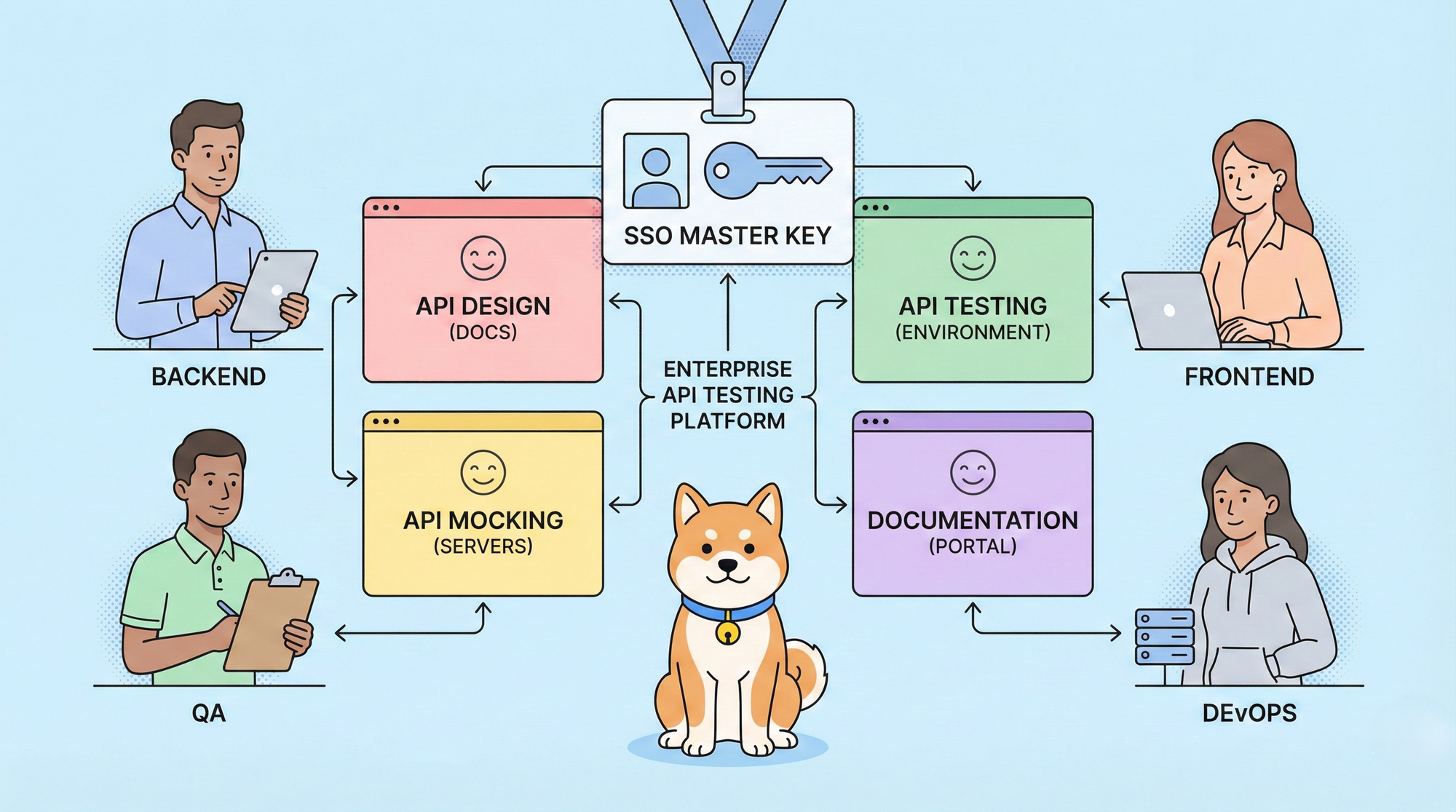It is vital to keep pace with the developments in the field of web development. In the course of this evolution, new frontend technologies are appearing, and a developer has to arm himself with the best possible tools to design applications that are effective, combinable, and of high standard. From packages to visual aids, such resources help manage tasks smoothly and improve work output in no time. In this article, we will be looking at the 10 best frontend tools that every developer must use in 2025. We will also present Apidog – a state-of-the-art API development tool that fits into frontend workflows so well that you will wonder how you ever did without it.

Why Choosing the Right Frontend Tools Matters
Selecting the right tools is crucial because they directly impact your productivity, code quality, and overall project success. Here are a few reasons why choosing the right set of tools matters:
- Efficiency: Tools like React or Tailwind CSS help you write less code while achieving more functionality. This allows you to focus on building features rather than dealing with low-level configurations or repetitive tasks.
- Collaboration: Tools like Figma or Apidog enhance collaboration by providing real-time feedback loops between designers, developers, and other stakeholders. This reduces miscommunication and helps teams stay aligned throughout the project lifecycle.
- Scalability: Whether you're working on a small project or an enterprise-level application, choosing scalable tools like Angular or Vue.js ensures that your application can grow without significant refactoring down the line.
- Performance: Tools like Chrome DevTools allow you to optimize your frontend performance by identifying bottlenecks in real-time. Similarly, using lightweight frameworks like Vue.js or utility-first CSS frameworks like Tailwind CSS ensures faster load times and better user experiences.
- Customization: Tools like Sass or Visual Studio Code offer extensive customization options that allow you to tailor your development environment to your specific needs. This leads to better organization of codebases and improved productivity.
1. React
React continues to dominate the frontend development space as one of the most popular JavaScript libraries for building user interfaces. Developed by Meta (formerly Facebook), React component-based architecture allows developers to create reusable UI components, making it easier to manage complex UIs. Its Virtual DOM feature ensures efficient rendering, which improves performance.

Key Features:
- Component-based architecture.
- Virtual DOM for optimized rendering.
- Strong community support and ecosystem.
- Hooks for managing state and side effects.
Pros:
- Easy to learn and use.
- Great for building dynamic and interactive UIs.
- Large ecosystem of libraries and tools.
Cons:
- Requires additional libraries for routing and state management (e.g., React Router, Redux).
Conclusion:
React remains a top choice for building modern web applications due to its flexibility, performance optimization, and strong community support.
2. Vue.js
Vue.js is another popular JavaScript framework that has gained traction due to its simplicity and flexibility. Vue is designed to be incrementally adoptable, meaning you can use as little or as much of it as you need. It's great for building both small-scale projects and large-scale applications.

Key Features:
- Reactive data binding.
- Component-based architecture similar to React.
- Built-in directives for DOM manipulation.
- It combines the best features of Angular and React.
Pros:
- Easy learning curve compared to other frameworks.
- Flexible integration with existing projects.
Cons:
- Smaller ecosystem compared to React or Angular.
Conclusion:
Vue.js is perfect for developers who want a lightweight framework that’s easy to integrate into existing projects while still offering powerful features.
3. Angular
Angular is a full-fledged frontend framework developed by Google that’s ideal for building large-scale web applications. Unlike React or Vue.js, Angular comes with everything you need out-of-the-box—routing, state management, HTTP client, and more—making it a complete solution for enterprise-level applications.

Key Features:
- Two-way data binding.
- Dependency injection.
- Built-in routing and state management.
Pros:
- Comprehensive framework with built-in tools.
- Strong support from Google and a large community.
Cons:
- Steeper learning curve compared to React or Vue.js.
Conclusion:
Angular is best suited for large-scale applications where having an all-in-one solution is crucial. It’s a great choice for teams looking for structure and consistency in their projects.
4. Tailwind CSS
Tailwind CSS is a utility-first CSS framework that allows developers to build custom designs directly in their markup without writing custom CSS from scratch. Unlike traditional CSS frameworks like Bootstrap, Tailwind doesn’t come with pre-designed components but instead provides low-level utility classes that can be combined to create unique designs.

Key Features:
- Utility-first approach to styling.
- Customizable design system.
- Responsive design out-of-the-box.
Pros:
- Highly customizable without writing custom CSS.
- Faster development with predefined utility classes.
Cons:
- Steeper learning curve compared to component-based frameworks like Bootstrap.
Conclusion:
Tailwind CSS is an excellent choice for developers who want full control over their designs without writing custom CSS from scratch. It’s perfect for teams looking to build responsive, modern UIs quickly.
5. Figma
Figma is a cloud-based design tool that allows designers and developers to collaborate in real-time. It’s widely used for creating user interfaces, prototypes, and design systems. Figma’s collaborative features make it easy for teams to work together on design projects without the need for constant file exchanges.

Key Features:
- Real-time collaboration between designers and developers.
- Vector editing tools.
- Prototyping capabilities.
Pros:
- Easy collaboration between designers and developers.
- Cloud-based with no need for installation.
Cons:
- Limited offline capabilities since it's cloud-based.
Conclusion:
Figma is essential for teams looking to streamline their design process through real-time collaboration. Its prototyping features make it easy to test designs before moving into development.
6. Chrome DevTools
Chrome DevTools is an essential set of web developer tools built directly into the Google Chrome browser. It allows developers to inspect elements, debug JavaScript code, analyze network activity, optimize performance, and much more—all in real-time as they develop their applications.

Key Features:
- Real-time editing of HTML/CSS/JavaScript.
- Performance analysis tools.
- Network request monitoring.
Pros:
- Built-in tool with no additional installation required.
Cons:
- Limited to Google Chrome browser.
Conclusion:
Chrome DevTools is indispensable for any web developer working on frontend projects. Its real-time editing and debugging capabilities help streamline the development process significantly.
7. Bootstrap
Bootstrap remains one of the most popular CSS frameworks due to its simplicity and ease of use. Developed by Twitter, Bootstrap offers a comprehensive set of pre-designed components like buttons, forms, modals, and navigation bars. It also includes a responsive grid system that makes it easier to build mobile-first websites quickly.

Key Features:
- Pre-designed UI components (buttons, forms, etc.).
- Responsive grid system.
Pros:
- Speeds up development by offering ready-made components.
Cons:
- Limited customization options unless overridden with custom CSS.
Conclusion:
Bootstrap is perfect for developers who want a quick way to create responsive websites without spending too much time on custom design work.
8. Sass
Sass (Syntactically Awesome Style Sheets) is a CSS preprocessor that adds extra functionalities like variables, nesting, mixins, inheritance, and more—making it easier to manage large stylesheets efficiently. Sass helps keep your styles organized while reducing repetition in your codebase.

Key Features:
- Variables for reusing values across stylesheets.
- Nesting selectors within one another.
Pros:
- Makes writing complex styles easier by adding logic-like features (variables/mixins).
Cons:
- Requires compilation into regular CSS before deployment.
Conclusion:
Sass is invaluable when working on large-scale projects where maintaining clean stylesheets becomes difficult over time!
9 Visual Studio Code
Visual Studio Code (VS Code) by Microsoft has become one of the most popular code editors among frontend developers because it provides powerful features such as IntelliSense smart completions based on variable types/functions definitions etc., integrated Git commands built-in debugger extensions marketplace offering thousands plugins enhance productivity even further!

Key Features:
- IntelliSense smart completions
- Integrated Git commands
- Extensions Marketplace
Pros:
- Lightweight fast
- Highly customizable
Cons:
- Can feel overwhelming due sheer number available plugins/extensions
Conclusion:
VS Code remains top-tier choice among devs thanks versatility customization options provided via extensions marketplace allowing tailor experience suit individual needs perfectly!
10 Apidog
Apidog stands out among API-centric tooling options offering comprehensive suite encompassing everything from designing/documenting/testing/debugging APIs—all under one roof! Recent updates introduced dynamic test case creation mimicking real-world scenarios ensuring APIs perform optimally under varying conditions coupled alongside automated/manual testing options providing seamless collaboration between team members via sprint branches/version control mechanisms ensuring smooth integration workflows across entire dev pipeline!

Key Features:
- Dynamic test case creation mimicking real-world scenarios
- Automated/manual testing options
- Sprint branches/version control mechanisms
Pros:
- Comprehensive suite covering entire API lifecycle management
- Seamless collaboration between team members
Cons: Primarily focused upon APIs may require additional tooling non-api centric projects
Conclusion:
Apidog remains top-tier option whenever dealing API-centric workflows thanks comprehensive suite encompassing everything needed throughout entire lifecycle management process ensuring seamless integration workflows across entire dev pipeline!
Conclusion
In 2025, the landscape of frontend development continues to evolve rapidly with new tools emerging every year. However, having the right set of tools can make all the difference in how efficiently you build products that scale well and provide excellent user experiences.
Choosing the right frontend tools can significantly improve your productivity as a developer while ensuring your applications are scalable efficient user-friendly! Whether leveraging power React, VueJS, Tailwind CSS, Figma, ChromeDevTools it is all about building the modern web tailoring everything for speed and quality in ways it has never been possible before!
Whether you're building a small personal project or working on a large-scale enterprise application, the right set of frontend tools can make all the difference in your development process. From frameworks like React and Vue.js to design tools like Figma, each tool plays a crucial role in streamlining workflows, improving collaboration, and enhancing the user experience.
By leveraging these top frontend tools effectively—and integrating powerful API management solutions like Apidog into your workflow—you’ll be well-equipped to tackle any project with confidence.




